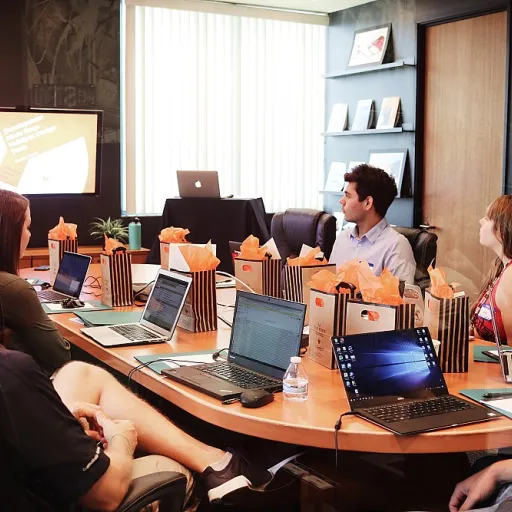
Understanding Talent Applications
Exploring the Role of Talent Applications in Recruitment
In today's competitive environment, the ability to effectively identify, assess, and onboard talent is crucial for businesses across various industries. Talent applications have emerged as a transformative tool in this context, offering platforms that streamline the recruitment process. These applications aid in handling vast volumes of applications, efficiently ensuring that the right candidates are matched with appropriate roles. Modern talent applications capitalize on advanced technologies to enhance user experience. They provide intuitive interfaces that simplify the process for both recruiters and applicants. Moreover, these platforms integrate with various social media channels and job boards, extending their reach and making it easier for candidates to apply. The entertainment industry, for instance, significantly benefits from such solutions. Talent services in this sector often require evaluating creative portfolios and managing multiple job positions simultaneously. Talent applications address these challenges by streamlining workflows and fostering better relationships between teams and potential candidates. Furthermore, companies offering talent applications have stringent privacy policies and have ensured that privacy concerns are adequately addressed, thereby maintaining trust and compliance with regulations. To learn more about how these systems are transforming recruitment processes, visit our insights on enhancing HR systems. This blog delves into the impact and intricacies of implementing talent applications within HR systems, showcasing real-world applications and outcomes.Key Features of Modern Talent Applications
Exploring the Core Elements
In the rapidly evolving talent industry, understanding the key features of modern talent applications is imperative for any organization seeking to align with today's dynamic requirements. These applications are designed to streamline the talent acquisition process, ensuring that the best candidates apply, integrate, and contribute to the team effectively.
Modern talent applications often include a variety of features aimed at enhancing the entire recruitment process:
- Automation: Automation within these applications aids in reducing the time and cost involved in the recruitment process. From resume screening to scheduling interviews, automation capabilities free up valuable resources.
- Data Analytics: Powerful data analytics help HR teams make data-driven decisions. By leveraging insights, teams can refine their hiring strategies and focusing on areas needing improvement.
- Integration with Other HR Systems: Seamless integration with existing HR systems can significantly enhance the management of talent services, thus fostering stronger relationships between human resources and potential candidates.
- Enhanced User Experience: A user-friendly interface ensures that the application process is smooth and engaging for potential applicants, which can lead to higher application rates and better candidate experiences.
- Customization: Applications offering customization options allow organizations to tailor processes according to their specific industry needs, whether it be entertainment services or corporate settings.
Understanding these features is crucial for teams aiming to build a robust and efficient talent acquisition system. For more detailed insights into how these applications can transform your HR processes, you can learn more about enhancing talent acquisition.
Benefits of Implementing Talent Applications
Unlocking the Benefits of Robust Talent Applications
Implementing talent applications can bring an array of benefits to organizations today, fundamentally transforming how talent acquisition is approached. With advanced applications, HR teams can streamline processes, resulting in more efficient recruitment and onboarding practices. Firstly, talent applications provide a centralized platform where all candidate information can be stored and accessed, enabling a smoother application process. This drastically improves the visibility and management capabilities for HR professionals, ensuring they can efficiently sort, evaluate, and apply necessary actions with potential candidates. Another significant advantage is the automation of repetitive tasks. This capability allows HR teams to focus more on building relationships and evaluating talent rather than being bogged down by administrative duties. Automated workflows, such as resume parsing and communication scheduling, reduce the time and effort required, ultimately saving costs and enhancing productivity. Integration with other HR services is also a crucial benefit. Modern talent services are designed to seamlessly connect with other HR functions, facilitating a more cohesive and effective approach to managing employees from hiring to retirement. For organizations within the entertainment industry, where talent acquisition is paramount, these applications offer customizable options to meet specific industry needs. By applying cutting-edge technology and analytics tools, companies can gain competitive advantages in sourcing and retaining the best talent. Furthermore, these applications come with robust data privacy and security features, ensuring compliance with privacy policies and regulations. This guarantees that sensitive information is protected, maintaining the trust of both candidates and employees. To learn more about effectively managing your HR functions and enhancing your approach to talent acquisition, consider this comprehensive guide on streamlining your vacation request process. It provides valuable insights into optimizing workflows and improving resource management, leading to a more productive workplace.Challenges in Adopting Talent Applications
Navigating the Adoption Process
Implementing a talent application system can refine your recruitment strategy, but adoption may present certain challenges. These hurdles can be meticulously managed with the right approach and understanding.- Ensuring Data Privacy: Data privacy and talent acquisition go hand in hand. Talent applications handle sensitive candidate information, necessitating rigorous privacy policies and secure data handling practices. To protect the rights reserved by candidates and uphold a strong privacy policy, companies must ensure their systems are compliant with all relevant data protection regulations.
- Aligning with Industry Needs: The application must be tailored to suit the specifics of the industry. For example, the entertainment industry may need features different from those in the tech sector. Understanding these nuances ensures the application meets the distinct needs of your team and streamlines the hiring process.
- Integrating with Existing Systems: Talent applications should seamlessly integrate with current HR tools and services. Organizations might face challenges if the new systems are incompatible with existing software, disrupting the application and onboarding processes. Collaboration among internal teams is crucial to navigate these technical challenges effectively.
- Training the HR Team: Human resources professionals need to be adequately trained to use the new system. A lack of training can impede the effectiveness of talent applications. Encouraging team members to learn and apply new skills will foster a more efficient hiring environment.
- Managing Change: Resistance to change is a common challenge in any technological shift. Overcoming this involves clear communication and promoting the benefits of the talent application. Highlighting how it enhances processes and relationships within the team can alleviate concerns.
Best Practices for Successful Talent Application Deployment
Ensuring Successful Integration of Talent Applications
Deploying talent applications effectively is crucial for any organization looking to streamline their talent acquisition processes. Below are some best practices that can guide teams towards successful implementation:- Thorough Requirement Analysis: A comprehensive understanding of the organization's needs is paramount. Align the application's features with the strategic goals of your talent strategies, ensuring that the tool provides solutions tailored to specific industry requirements, even those in specialized sectors such as the entertainment industry.
- Cross-Departmental Collaboration: Foster relationships among different teams, including HR, IT, and other departments, to ensure a smooth integration process. Collaboration not only facilitates a seamless transition but also helps in addressing any challenges early in the process.
- Focus on User Adoption: Training and support are key in driving user adoption. Implement a robust training program to help personnel learn and apply the new system effectively. This step should also address privacy policy and data management practices inherent in the system.
- Customization and Scalability: Choose applications that offer flexibility allowing your organization to customize systems according to evolving needs. Quality talent services should be scalable to grow alongside your organization, adapting to changes in size or industry dynamics.
- Regular Evaluation and Updates: Implement a policy of periodic assessment to gauge the system's performance. Stay informed about new updates and features that might enhance your platform's capabilities, maintaining competitiveness in the market.
Future Trends in Talent Applications
Shaping Tomorrow: Emerging Trends in Talent Applications
The talent industry is witnessing a dynamic shift influenced by technology and evolving business needs. As organizations seek to enhance their talent acquisition efforts, new trends in applications are emerging that promise to redefine the recruitment landscape. These trends are not merely enhancements but are transformative elements that can significantly impact your recruitment process.- AI and Machine Learning Integration: The integration of AI and machine learning technologies continues to evolve, providing more than just automation. These applications now offer predictive analytics to anticipate candidate success, reduce bias in the hiring process, and enhance the personalization of talent services.
- Data-Driven Recruitment: In today's data-centric world, talent applications are increasingly leveraging data analytics. This allows for better decision-making and creates deeper insights into the recruitment pipeline. Organizations are using these insights to streamline their hiring processes and build stronger relationships with potential candidates.
- Emphasis on Privacy and Security: With the increasing concern over data privacy, applications are placing a higher focus on secure platforms. Candidates and companies alike demand robust privacy policies, and having rights reserved over personal data is crucial for maintaining trust.
- Mobile-Friendly Platforms: As mobile usage continues to rise, talent applications are transitioning to mobile-first designs. This ensures that the application processes are accessible and seamless across various devices, thereby increasing the convenience for potential talents to apply today.
- Enhanced Candidate Experience: Applications are now increasingly focusing on creating better candidate experiences through streamlined processes and user-friendly interfaces. This helps in attracting top talent and improves overall engagement.
- Remote Work and Virtual Hiring: With the rise of remote work models, talent applications are adapting by including features that support virtual interviews and remote onboarding, catering to the entertainment industry and beyond.












